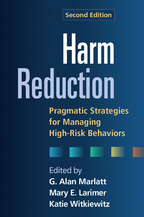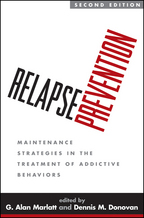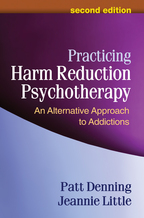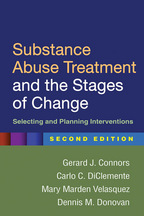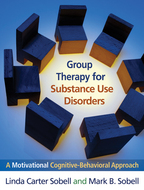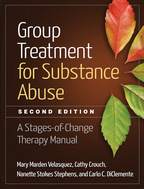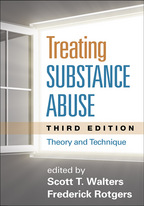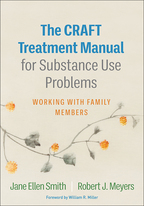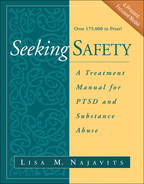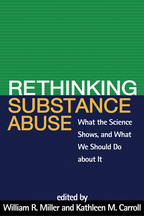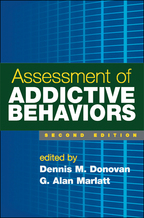Harm Reduction
Second Edition
Pragmatic Strategies for Managing High-Risk Behaviors
Edited by G. Alan Marlatt, Mary E. Larimer, and Katie Witkiewitz
Hardcovere-bookprint + e-book
Hardcover
orderDecember 7, 2011
ISBN 9781462502561
Price: $61.00 396 Pages
Size: 6" x 9"
Sign up for emails on upcoming titles on Addictions (with special discounts)!
“A very good introductory guide through the often difficult and controversial terrain of harm reduction.”

—Drug and Alcohol Review
“An extremely important and valuable work....The real impact of this seminal volume is that it makes the case for harm reduction as a powerful model for both treatment and public policy innovations.”

—Psychiatric Services
“This realistic, pragmatic approach to managing high-risk behaviors is solidly based on research evidence and clear logic.”

—Choice
“Harm reduction is a pragmatic approach that meets people 'where they are at.' This excellent book brings together researchers and practitioners who have made significant contributions to the growth and acceptance of harm reduction as an integral, viable, and effective approach to minimizing the negative consequences of high-risk behaviors. The second edition provides an updated, expanded review of the current status of harm reduction approaches, their applications, and the evidence that supports them. It is a valuable resource for practitioners and researchers and an essential text for graduate students in addictive behaviors, psychology, and public health.”

—Dennis M. Donovan, PhD, Director, Alcohol and Drug Abuse Institute, University of Washington School of Medicine
“Marlatt and his colleagues have compiled what is certain to be the gold-standard reference, covering the history, evolution, and applications of harm reduction strategies in clinical practice, as well as controversies surrounding harm reduction. Harm reduction is founded on the idea that people are more likely to change risk behaviors when the approaches supporting these changes are intimately client centered—even when such approaches conflict with social mores. The book shows how compassion and safety considerations create a fulcrum for balancing complex clinical decision making that both reduces harm and engages individuals in effective treatment.”

—Hilary S. Connery, MD, PhD, Department of Psychiatry, Harvard Medical School; Division of Alcohol and Drug Abuse, McLean Hospital
“The original book was a revelation to me; the second edition makes another leap forward. Harm Reduction should be required reading for anyone who wants to understand behavior change. Both professionals and students will benefit from the up-to-date research reviews and practical applications for a variety of high-risk behaviors. Harm reduction principles and strategies offer a crucial counterpoint to the disease model and abstinence-only orientations. The material in this book provides a blueprint for enabling individual and social change.”

—Jan W. Murdoch, PhD, Department of Psychology, Clemson University
“This eloquent, compassionate book outlines pragmatic ways to identify and reduce high-risk behaviors associated with use of a broad spectrum of drugs, including alcohol, amphetamines, cannabis, cocaine, heroin, and tobacco, as well as high-risk sexual behaviors. Tailored strategies designed to meet the needs of diverse cultures and communities are described. This important book is essential reading for workers in the field, and should be compulsory reading for policymakers.”

—Frank Ryan, CPsychol, AFBPsS, Honorary Senior Lecturer, Centre for Mental Health Research, Imperial College London, United Kingdom
—Drug and Alcohol Review
“An extremely important and valuable work....The real impact of this seminal volume is that it makes the case for harm reduction as a powerful model for both treatment and public policy innovations.”
—Psychiatric Services
“This realistic, pragmatic approach to managing high-risk behaviors is solidly based on research evidence and clear logic.”
—Choice
“Harm reduction is a pragmatic approach that meets people 'where they are at.' This excellent book brings together researchers and practitioners who have made significant contributions to the growth and acceptance of harm reduction as an integral, viable, and effective approach to minimizing the negative consequences of high-risk behaviors. The second edition provides an updated, expanded review of the current status of harm reduction approaches, their applications, and the evidence that supports them. It is a valuable resource for practitioners and researchers and an essential text for graduate students in addictive behaviors, psychology, and public health.”
—Dennis M. Donovan, PhD, Director, Alcohol and Drug Abuse Institute, University of Washington School of Medicine
“Marlatt and his colleagues have compiled what is certain to be the gold-standard reference, covering the history, evolution, and applications of harm reduction strategies in clinical practice, as well as controversies surrounding harm reduction. Harm reduction is founded on the idea that people are more likely to change risk behaviors when the approaches supporting these changes are intimately client centered—even when such approaches conflict with social mores. The book shows how compassion and safety considerations create a fulcrum for balancing complex clinical decision making that both reduces harm and engages individuals in effective treatment.”
—Hilary S. Connery, MD, PhD, Department of Psychiatry, Harvard Medical School; Division of Alcohol and Drug Abuse, McLean Hospital
“The original book was a revelation to me; the second edition makes another leap forward. Harm Reduction should be required reading for anyone who wants to understand behavior change. Both professionals and students will benefit from the up-to-date research reviews and practical applications for a variety of high-risk behaviors. Harm reduction principles and strategies offer a crucial counterpoint to the disease model and abstinence-only orientations. The material in this book provides a blueprint for enabling individual and social change.”
—Jan W. Murdoch, PhD, Department of Psychology, Clemson University
“This eloquent, compassionate book outlines pragmatic ways to identify and reduce high-risk behaviors associated with use of a broad spectrum of drugs, including alcohol, amphetamines, cannabis, cocaine, heroin, and tobacco, as well as high-risk sexual behaviors. Tailored strategies designed to meet the needs of diverse cultures and communities are described. This important book is essential reading for workers in the field, and should be compulsory reading for policymakers.”
—Frank Ryan, CPsychol, AFBPsS, Honorary Senior Lecturer, Centre for Mental Health Research, Imperial College London, United Kingdom

